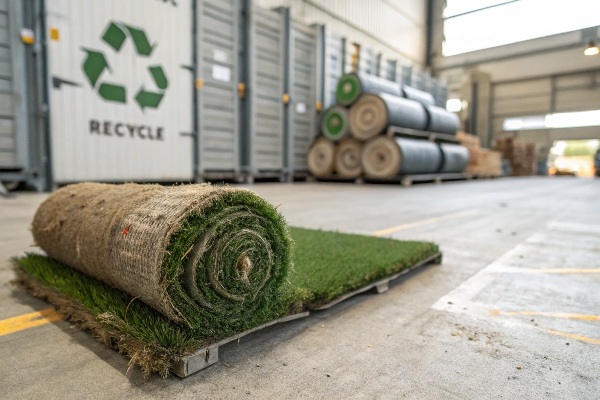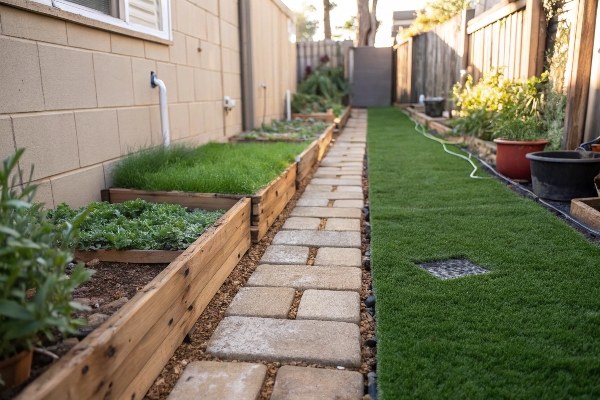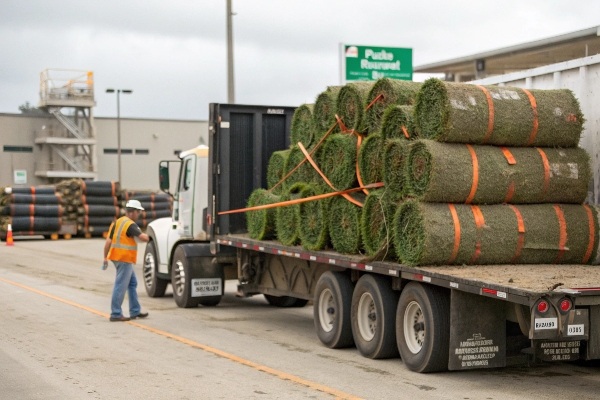Your artificial turf has reached the end of its life. Throwing it in a landfill feels wasteful and bad for the planet. You need a sustainable solution for disposal.
Yes, artificial grass can be recycled. The process is challenging because the turf is made of multiple materials like plastic, backing, and infill. However, specialized facilities exist that can separate these components and turn them into new raw materials for other products, making it an eco-friendly option.

I’ve spent over a decade in the artificial turf industry, from the factory floor to leading a sales team. A question I get all the time from business owners is about the end-of-life plan for their turf. It’s a great question. They are not just investing in a product for today, but also thinking about its impact tomorrow. Many believe that old turf just ends up in a landfill, but that isn’t the only option. The industry has made significant progress in finding sustainable solutions. Let’s look at what you can actually do when your artificial grass needs to be replaced.
What to do with old artificial grass?
You’ve invested in a brand new turf field. But now, what about the old one? A huge roll of used turf takes up space, and you know disposal is complicated.
The best options for old artificial grass are recycling1 or repurposing2. Recycling breaks the turf down into raw materials. Repurposing gives it a second life in smaller projects like batting cages3, pet areas4, gym flooring5, or on balconies. Landfilling should always be your last resort.

When a client needs to replace a large sports field, simply throwing the old turf away is a massive waste. I always advise them to first consider giving it a second life. A full-size football field might be worn out for professional play, but many sections are still perfectly usable for less demanding applications. Breaking down your options helps you make the most responsible and cost-effective choice. It’s about thinking creatively instead of just thinking about disposal.
The Three Main Options
The path you choose depends on the condition of your turf and the resources available in your area. Let’s compare the three main routes you can take.
| Option | Description | Best For |
|---|---|---|
| Recycle | The turf is sent to a specialized plant, shredded, and its components (plastic fibers, backing, infill) are separated for reuse. | Environmentally conscious projects where the turf is too worn for a second use. |
| Repurpose | The old turf is cleaned and cut into smaller pieces for other uses. | Turf that is still in decent condition but no longer meets standards for its original purpose. |
| Dispose | The turf is sent to a landfill. This is the least preferred option due to its environmental impact. | Turf that is heavily damaged, contaminated, or when no other options are available. |
Ideas for Repurposing
I once worked with a baseball club that replaced its main field. Instead of throwing the old turf out, they used the best sections to create several new batting cages3 and player warm-up areas. This saved them a lot of money on materials for the new facilities. Repurposing is a fantastic way to extend the value of your initial investment. Here are a few common ideas:
- Dog runs or kennels
- Flooring for a home gym or shed
- Paths and walkways in a garden
- Mats for construction sites
- Liners for truck beds
How do I dispose of artificial grass near me?
You’re ready to get rid of your old turf, but you’re stuck. Local regulations are unclear, and you have no idea who to even call. Finding the right disposal method feels difficult.
To find a local disposal option, start by contacting your city’s waste management6 service to ask about rules for bulky items. Next, contact artificial turf installers or suppliers in your area, as they often have recycling programs7//texasartificiallawns.com/blog/artificial-turf-for-environment/)1 programs. Also, search online for specialized turf recyclers.

Finding a local solution is the key to responsible disposal. The options available can change greatly from one city to another. As a supplier, I make it a point to understand the logistics my clients face. From my experience, the problem isn’t usually a lack of options, but a lack of information. You have to be proactive and ask the right questions to the right people. Here is a simple, step-by-step process you can follow to find the best disposal solution in your specific area.
A Practical Action Plan
Follow these steps to find a reliable and responsible way to handle your old artificial turf.
Step 1: Contact Your Supplier or Installer
Your first call should be to the company that sold or installed your turf. The artificial grass industry is becoming more aware of its environmental responsibilities. Many companies now have established take-back programs or partnerships with recycling1 facilities. When I help a new client, I encourage them to ask about this from the beginning. It shows foresight and helps build a long-term plan for their investment.
Step 2: Check with Local Authorities
Your local government is your next best resource. Go to your city or county’s website and look for the waste management6 or public works department. Their guidelines will tell you how to handle bulky construction materials. Some municipalities have special collection days or designated drop-off locations for items like turf. Others might have contracts with specific recycling1 centers.
Step 3: Search for a Specialist
If the first two steps don’t lead to a solution, it’s time to look for a private company that specializes in artificial turf recycling1. The market for this service is growing. Use search terms like "artificial grass recycling1 [Your City]" or "synthetic turf disposal services8" online. These companies have the proper equipment to handle the entire process, from pickup to final recycling1.
| Who to Contact | Key Question to Ask | Why It’s Important |
|---|---|---|
| Turf Supplier/Installer | "Do you offer a take-back or recycling1 service for old turf?" | They are experts and may have an established, cost-effective process. |
| City Waste Management | "What are the local rules for disposing of artificial grass?" | Ensures you comply with local laws and avoid potential fines. |
| Specialized Recyclers | "What is your process and what are the costs for turf recycling1?" | These companies provide an end-to-end, environmentally friendly solution. |
Conclusion
Recycling or repurposing your old turf is possible and responsible. By planning ahead and asking the right questions, you can find a sustainable solution that benefits both you and the environment.
-
Explore the advantages of recycling artificial grass to understand its environmental impact and benefits. ↩ ↩ ↩ ↩ ↩ ↩ ↩ ↩ ↩
-
Discover creative ways to repurpose old artificial grass for various projects and save money. ↩
-
Find out how artificial grass enhances batting cages and improves player experience. ↩ ↩
-
Explore the advantages of using artificial grass for pet areas, including maintenance and comfort. ↩
-
Learn why artificial grass is becoming a popular choice for gym flooring and its benefits. ↩
-
Understand the best practices for managing waste related to artificial grass disposal. ↩ ↩
-
Discover various recycling programs that can help you dispose of artificial turf responsibly. ↩
-
Learn about synthetic turf disposal services and how they can help with recycling and disposal. ↩
_画板-1.png)
_画板-1.png)